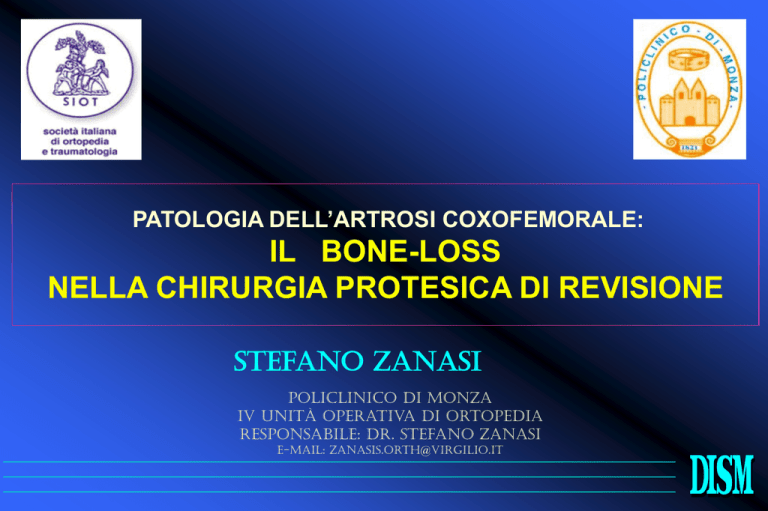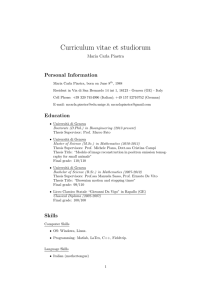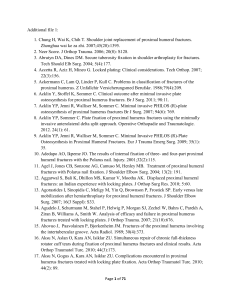periprosthetic bone - loss classification and problematics related to
advertisement

PATOLOGIA DELL’ARTROSI COXOFEMORALE: IL BONE-LOSS NELLA CHIRURGIA PROTESICA DI REVISIONE Stefano Zanasi Policlinico di Monza IV Unità Operativa di Ortopedia Responsabile: Dr. Stefano Zanasi e-mail: zanasis.orth@virgilio.it STEFANO ZANASI REVISION HIP ARTHROPLASTY NEEDS TO RECOGNIZE BONE LOSS REVISION HIP ARTHROPLASTY NEEDS OF BONE-LOSS CLASSIFICATION BONE-LOSS CLASSIFICATION • PRE-OPERATIVE PLANNING • COMMON LANGUAGE for REPORTING SURGICAL RESULTS ( A.A.O.S. COMMITEE ON THE HIP, 1993 ) BONE LOSS CLASSIFICATIONS • • • • • ° Engelbrecht ( 1987 ) Gustilo-Pasternak (1988) Engh et Coll. ( 1988 ) Tanzer et Coll. ( 1992 ) Gross et Coll. (1993 Chandler et Coll. (1989) - Oakeshott et Coll. (1987) - Mallory et Coll. (1988) - Schmitt et Coll. (1992) - Pipino - Molfetta (1992) - Paprosky et Coll. (1993) - D’Antonio et Coll. (1995) LIMITS of CLASSIFICATIONS • COMPLEXITY difficulty in application • RELATED to IMAGING • MANY CASES BORDERLINE • INTRAOPERATIVE DEVELOPMENT OF BONE DEFECTS The BONE-LOSS CLASSIFICATION in hip revision surgery Italian Society of Revision Surgery-GIR ACETABULAR BONE-LOSS GRADE I ° Loosening GRADE II ° Loosening ° Enlargement and ° Enlargement and deformation of deformation of acetabulum acetabulum GRADE III ° Loosening ° Enlargement and deformation of acetabulum Defect in TWO• NO wall defect Defect in ONE wall MORE walls GRADE IV MASSIVE and OVERALL Periacetab. Defect FEMORAL BONE-LOSS GRADE I Proximal canal enlargement with cortical thinning NO cortical zone defect GRADE II GRADE III Proximal canal enlargement with cortical thinning Proximal canal enlargement with cortical thinning Defect in TWO or MORE zones Defect in ONE cortical zone GRADE IV PROXIMAL CIRCUMFERENTIAL & MASSIVE Defect ACETABULAR BONE-LOSS (Grade I – cavitary defect) • Loosening Host bone CAN CONTAIN the cup and ensure its stability. • Enlargement and deformation of acetabulum NO WALL DEFECT C.O.R. is not (or slightly) translated ACETABULAR BONE-LOSS (Grade I) FILLING of the cavity SURGICAL STRATEGY (Larger or elliptical cups, Cement, Bone chips, etc.) ACETABULAR BONE-LOSS (Grade II ) Loosening • Enlargement and deformation of acetabulum Defect in ONE WALL Host bone MAY NOT CONTAIN the Cup C.O.R. always translated ACETABULAR BONE-LOSS (Grade II) SURGICAL RECONSTRUCTION of the DISRUPTED WALL STRATEGY (Rings, Cages, Conventional or Jambo cup, Bone grafts, etc.) b a c ACETABULAR BONE-LOSS (Grade III) • Loosening - Host bone CAN'T CONTAIN the CUP • Enlargement and deformation of acetabulum - DEFECT of SUPPORTING WALL • Defect in TWO or MORE WALLS - ARTICULAR BIOMECHANICS ALTERED ACETABULAR BONE-LOSS (Grade III) SURGICAL STRATEGY CUP ANCHORAGE in intact bone ( Rings, Cages, Conventional or Jumbo cup, Stemmed cup, Oblong or asymetric cups, Morsellized bone grafts, etc. ) ACETABULAR BONE-LOSS (Grade IV) MASSIVE and OVERALL PERIACETABULAR Defects (hemipelvis fracture) Host bone CAN’T CONTAIN the cup Biomechanics is deeply altered ACETABULAR BONE-LOSS (Grade IV) SURGICAL STRATEGY ANCHORAGE in the superior wall (Rings, Cages, Stemmed cups, Allografts, etc. ) FEMORAL BONE-LOSS (Grade I – cavitay defect) Proximal canal enlargement with cortical thinning NO CORTICAL ZONE Defect PROXIMAL FEMUR CAN’T CONTAIN the stem Biomechanics is not altered ( leg length, muscle balance, head/neck offset ) FEMORAL BONE-LOSS (Grade I) FILLING of the femoral canal SURGICAL STRATEGY (larger and longer stem, cement, morsellized grafts, etc. Restoring the appropriate head-neck offset FEMORAL BONE-LOSS (Grade II – segmental defect) Defect in ONE CORTICAL ZONE (Lesser trochanter, reabsorption, osteolysis, perforation, window, etc.) Proximal femur MAY CONTAIN the stem and ensure its stability. Biomechanics is partially compromised FEMORAL BONE-LOSS (Grade II) SURGICAL RECONSTRUCTION of cortical defect (bone grafts, proximal anchorage with long stem, ev. cerclages ) STRATEGY Restoring the appropriate head/neck offset FEMORAL BONE-LOSS (Grade III) Defect of TWO or MORE ZONES Proximal femur CAN'T CONTAIN and STABILIZE the stem total PROXIMAL CIRCUNFERENTIAL defect Biomechanical ability is significantly compromised FEMORAL BONE-LOSS (Grade III) ANCHORAGE in INTACT BONE (Below the defect) SURGICAL STRATEGY Modular or Custom-made stems Distal anchorage stems Massive allografts, FEMORAL BONE-LOSS (Grade IV) PROXIMAL CIRCUNFERENTIAL MASSIVE defect Proximal bone CAN’ T CONTAIN the stem Biomechanical ability is significantly compromized FEMORAL BONE-LOSS (Grade IV) SURGICAL STRATEGY ANCHORAGE the stem in distal bone Massive allografts, Distal anchorage stems, Modular stems (tumor prosth.) Grazie

